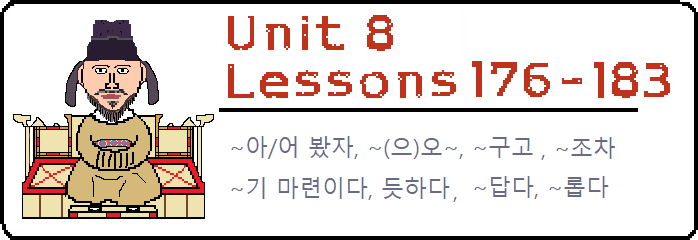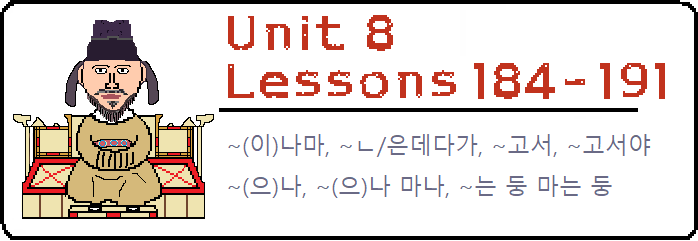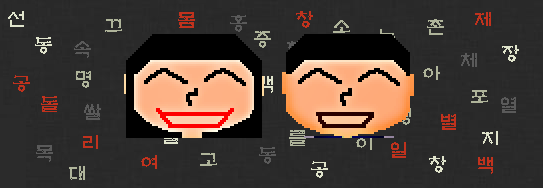 Hello. My name is Wang Kŏn. I unified the Korean peninsula and founded the Goryeo Dynasty in the year 918. In fact, that is where the modern “Korea’ got its name. They later called me “Taejo” 태조 (太祖) to mean that I was a “great king.” I will be looking over you as you learn through Unit 8. The grammar now is getting very difficult. After this unit, you can get very close to calling yourself a fluent Korean speaker.
Hello. My name is Wang Kŏn. I unified the Korean peninsula and founded the Goryeo Dynasty in the year 918. In fact, that is where the modern “Korea’ got its name. They later called me “Taejo” 태조 (太祖) to mean that I was a “great king.” I will be looking over you as you learn through Unit 8. The grammar now is getting very difficult. After this unit, you can get very close to calling yourself a fluent Korean speaker.
 In these lessons, you’ll explore several advanced Korean grammar patterns that add nuance and sophistication to your speech. You’ll learn how to express futility with ~아/어 봤자, and discover the formal and literary uses of ~(으)오 and ~(으)오니, which often appear in older or more elegant styles of writing. Then you will go on to learn about ~구요, a softer and more natural alternative to ~고 for connecting sentences in conversation. After that, you will learn about ~기 마련이다, meaning “it’s bound to happen,” and ~ㄴ/은/는/을/ㄹ 듯하다, used to describe something that “seems like” or “appears to be.” Finally, you’ll deepen your understanding of descriptive endings such as ~조차, ~답다, and ~롭다, which help convey emphasis, identity, and qualities more precisely in Korean. In these lessons, you’ll explore several advanced Korean grammar patterns that add nuance and sophistication to your speech. You’ll learn how to express futility with ~아/어 봤자, and discover the formal and literary uses of ~(으)오 and ~(으)오니, which often appear in older or more elegant styles of writing. Then you will go on to learn about ~구요, a softer and more natural alternative to ~고 for connecting sentences in conversation. After that, you will learn about ~기 마련이다, meaning “it’s bound to happen,” and ~ㄴ/은/는/을/ㄹ 듯하다, used to describe something that “seems like” or “appears to be.” Finally, you’ll deepen your understanding of descriptive endings such as ~조차, ~답다, and ~롭다, which help convey emphasis, identity, and qualities more precisely in Korean. |
 In this set of lessons, you’ll learn how to express subtle shades of contrast, cause, and reluctant acceptance in Korean. You’ll start with ~(이)나마, which shows acceptance of something less than ideal, and ~ㄴ/은/는데다가, used to “pile on” or add more information to a statement. Then you’ll explore ~고서 and ~고서야, two patterns that describe actions happening in sequence or things that occur only after something else. You’ll also uncover multiple uses of ~(으)나, one for showing contrast (“even though”) and another for expressing irrelevance among options (“no matter which”). Finally, you’ll study expressions like ~(으)나 마나 and ~는 둥 마는 둥, which describe doing something pointlessly or half-heartedly. In this set of lessons, you’ll learn how to express subtle shades of contrast, cause, and reluctant acceptance in Korean. You’ll start with ~(이)나마, which shows acceptance of something less than ideal, and ~ㄴ/은/는데다가, used to “pile on” or add more information to a statement. Then you’ll explore ~고서 and ~고서야, two patterns that describe actions happening in sequence or things that occur only after something else. You’ll also uncover multiple uses of ~(으)나, one for showing contrast (“even though”) and another for expressing irrelevance among options (“no matter which”). Finally, you’ll study expressions like ~(으)나 마나 and ~는 둥 마는 둥, which describe doing something pointlessly or half-heartedly. |
 In this group of lessons, you will learn the nurturing, gentle tone behind ~ㄴ/는단다 and ~(으)렴. You’ll also explore how Korean handles recurring or historical events and formal phrasing used in legal documents, giving you insight into more official registers of the language. The lessons continue with advanced expressions such as 그지없다, 겸/겸사겸사, and 바, which allow you to describe extremes, combine purposes, and refer back to previous information with nuance. Finally, you’ll deepen your expressive range with patterns like ~ㄴ/은 셈이다, ~은/는커녕, and the verb 부리다, helping you describe comparisons, shortcomings, and displayed behaviors with precision. In this group of lessons, you will learn the nurturing, gentle tone behind ~ㄴ/는단다 and ~(으)렴. You’ll also explore how Korean handles recurring or historical events and formal phrasing used in legal documents, giving you insight into more official registers of the language. The lessons continue with advanced expressions such as 그지없다, 겸/겸사겸사, and 바, which allow you to describe extremes, combine purposes, and refer back to previous information with nuance. Finally, you’ll deepen your expressive range with patterns like ~ㄴ/은 셈이다, ~은/는커녕, and the verb 부리다, helping you describe comparisons, shortcomings, and displayed behaviors with precision. |
|
 Hello. My name is Wang Kŏn. I unified the Korean peninsula and founded the Goryeo Dynasty in the year 918. In fact, that is where the modern “Korea’ got its name. They later called me “Taejo” 태조 (太祖) to mean that I was a “great king.” I will be looking over you as you learn through Unit 8. The grammar now is getting very difficult. After this unit, you can get very close to calling yourself a fluent Korean speaker.
Hello. My name is Wang Kŏn. I unified the Korean peninsula and founded the Goryeo Dynasty in the year 918. In fact, that is where the modern “Korea’ got its name. They later called me “Taejo” 태조 (太祖) to mean that I was a “great king.” I will be looking over you as you learn through Unit 8. The grammar now is getting very difficult. After this unit, you can get very close to calling yourself a fluent Korean speaker.



